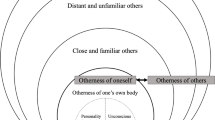Abstract
In this article, I retrace a development in psychoanalytic conceptions of the experience of otherness from narcissistic loss to enjoyment of difference and argue that the latter conception of otherness in terms of difference involves a subtle but important ambiguity. In one sense, difference remains compatible with the objectification of the other; I therefore propose that the experience of otherness is an experience of the freedom of the other, which is not compatible with objectification. And I show how certain basic affective interpersonal attitudes (such as feeling jealous or feeling self-conscious) presuppose an experience of others as free.
Similar content being viewed by others
Notes
He might do so in different ways. For instance, he might “mourn” his narcissistic self-sufficiency and develop an “anaclitic” attachment to his caregivers. Or, he might be unable to mourn his narcissistic self-sufficiency and form a “narcissistic” attachment to others, predicated on his view of them as “someone who was once part of himself” or “what he himself would like to be” (1956 XIV, 90). The latter yields a “melancholic” identification with the caregiver, which is at the root of the “ego ideal” (1956 XIV, 94). I shall ignore these complications here.
It is worth noting the importance of a very similar idea in Kant and post-Kantian philosophy that a representation has “objective” content insofar as it constrains the “freedom” of the knowing subject, who is not “free” to represent it in another way. For instance, the temporal order of a sequence of representations is subjective if it can be varied at will (as an example, Kant (1781/1998) mentions the order in which we survey, in reality or imagination, the various parts of a house), and objective if it cannot (for instance, the order in which we represent the positions of a boat going downstream). Among post-Kantian philosophers, Nietzsche is sometimes taken to argue that we know to be objectively real those among the contents of our representations which we cannot, or could not, remove, control, or dispose of at will, i.e., which would offer us resistance (see Poellner (1995, p. 287)).
In classic Freudian theory, the desire to be loved arises in conditions in which we realize the limits of our own power and the extent of our dependence on others for the gratification of our drives. In this theory, to want to be loved is to want the assistance of others in the gratification of our drives, and this desire is satisfied by the fact that they so assist us (with sufficient reliability). But subsequent psychoanalytic writers soon, and unsurprisingly, emphasize that my desire to be loved is the desire for others to form a certain distinctive attitude toward me. The issue I have taken up concerns the specification of the character of this distinctive attitude, which is the proper object of the desire to be loved.
On narcissistic rage, see Kohut (1972). A poignant description of what happens when a person seeking self-buttressing validation fails to treat the other as a full-blown subject may be found in the second part of Dostoyevsky’s Notes from the Underground (1972). Dostoyevsky recounts the vicissitudes of the relationship between the narrator and a young prostitute named Lisa. In order to impress Lisa, the narrator deceives her into thinking he is of a higher social and economic standing than he actually is. He can therefore not experience her as a free subject, capable of forming a true representation of who he is. As a consequence, he cannot gain any validation from her love and admiration, even when, since as it turns out Lisa is not fooled by his representations, they are genuine.
References
Baier, A. (1986). Trust and antitrust. Ethics, 96, 231–260.
Benjamin, J. (1999). Recognition and destruction: An outline of intersubjectivity. In S. Mitchell & L. Aron (Eds.), Relational psychoanalysis: The emergence of a tradition (pp. 181–210). New York: Analytic Press.
Dostoyevsky, F. (1972). Notes from the underground. Trans. J. Coulson. London: Penguin Books.
Farrell, D. (1980). Jealousy. Philosophical Review, 59, 527–559.
Freud, S. (1956–74) The standard edition of the complete psychological works of Sigmund Freud. Trans. J. Strachey. London: Hogarth Press.
Kant, I. (1781/1998). The critique of pure reason. Trans. P. Guyer & A. Wood. Cambridge: Cambridge University Press.
Klein, M. (1957). Envy and gratitude. In R. Money-Kyrle (Ed.), The writings of Melanie Klein III (pp. 176–235). New York: McMillan.
Kohut, H. (1972). Thoughts on narcissism and narcissistic rage. Psychoanalytic Study of the Child, 27, 360–400.
Poellner, P. (1995). Nietzsche and metaphysics. Oxford: Oxford University Press.
Sartre J. -P. (1943). Being and nothingness. Trans. H. Barnes. New York: Washington Square Press.
Winnicott, D. W. (1965). The maturational process and the facilitating environment. Madison: International Universities Press.
Winnicott, D. W. (1971). Playing and reality. London: Tavistock.
Acknowledgments
An earlier version of this paper was discussed at a seminar at the Erikson Institute, Austen Riggs Center. The paper has also benefited from brief but helpful exchanges with Lynne Layton and Frank Summers.
Author information
Authors and Affiliations
Corresponding author
Rights and permissions
About this article
Cite this article
Reginster, B. Three Views of Otherness. Pastoral Psychol 62, 437–449 (2013). https://doi.org/10.1007/s11089-012-0471-y
Published:
Issue Date:
DOI: https://doi.org/10.1007/s11089-012-0471-y




